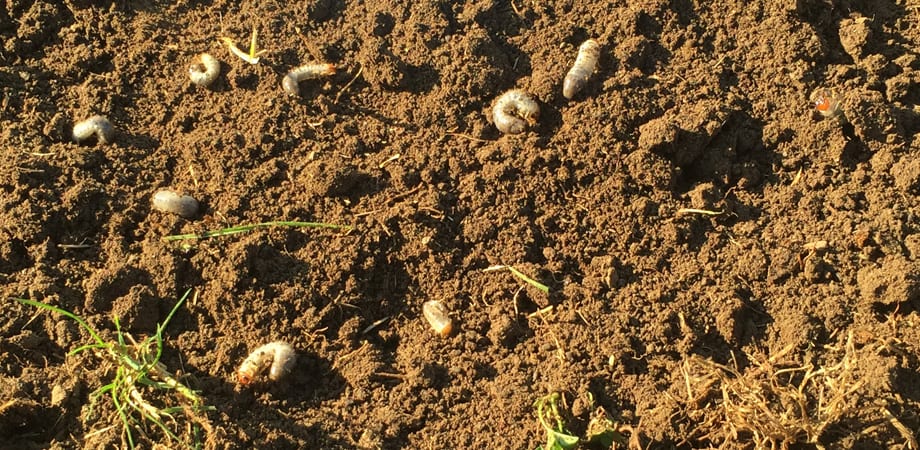Grubs may be out of sight, but they should never be out of mind—especially if you’re a lawn care professional. Simply put, grubs feed on the roots of turfgrass, and that’s bad for your customers’ lawns. With the right products and application timing, though, you can eliminate grubs before they cause damage.
Grub Crash Course
If you’re already familiar with the ins and outs of grubs, you can skip to the next section. Grubs are the larval form of different types of scarab beetles, and they become active in mid-summer and early fall, for the most part. They are attracted to healthy, well-irrigated turf, which is where they like to lay their eggs. Moisture is a very important part of the hatching process, and dry summers often result in less damage since fewer eggs hatch. Once an area has been infested with grubs, they will want to stick around. They think of your customers’ turf as their property, and it’s in your best interest to evict them before they trash the place.
Identifying an Infestation
Grubs typically pop up right in the middle of the summer season, usually after water is introduced to an area. Once their eggs hatch, the grubs (larvae) start eating the roots, which is when you’ll start seeing the negative effects on your customers’ turf.
If you encounter brown patches, sponge-like turf (wet and mushy, even when it hasn’t rained), or you can peel the turf up like a welcome mat, those are telltale signs of a grub infestation. This damage often isn’t noticed until a rain event, since symptoms can also look like drought stress.
Get Rid of Grubs Before They Arrive
An ounce of prevention (or whatever the label recommends) is better than a gallon of cure. Applying a preventative insecticide in the early summer will ensure that larvae don’t get the chance to turn your customers’ lawns into tasty meals.
Early Preventative (April/May)
The early bird kills the grub. An early preventative application will intercept grubs before they hatch or as they emerge. Standout options include Balata and Durentis, two liquid insecticides that contain chlorantraniliprole, have low use rates, and can provide season-long control when applied early in the season. They also have the added benefit of giving you up to 60 days of surface feeder control, which includes armyworm, cutworm, and sod webworm.
Late Preventative (June/July)
If you missed the early application window, you can still catch the tail end of the egg-laying season. This is when targeted applications of imidacloprid-based products shine. Fertilizers containing Merit, along with Mallet (a standalone product that comes in liquid and granular form), are two standout options that are highly effective and won’t drain your wallet. If you’re looking to accomplish two things at once, keep in mind that other fertilizers, including 21-0-0 by The Andersons, contain imidacloprid.
Arena, a clothianidin option that comes in both liquid and granular form, and Aloft, a dual-action formulation (clothianidin and bifenthrin) that’s also available as a liquid or granular, are also two reliable systemic options.
It’s important to note that this timeframe is your last chance to prevent grubs from taking root—literally.
Rescue Applications
If you did not apply a preventative and start seeing signs of damage (or the insect itself) from August through October, treat the area as soon as possible. Remember that while curative applications will be effective, root damage has already occurred, and curative treatments are often more costly than preventative ones.
A popular curative option is Dylox, a trichlorfon-based product. It works within 24 hours, so if you need rapid knockdown, Dylox is your best choice. A clothianidin product will also provide excellent results. Merit will also provide around 80-85% control when applied through mid-September, but will take up to a week to kill the grub itself.
A Few Parting Tips
If you’re dealing with very dry soil, grubs might be lower in the soil profile than expected. Some chemicals will have to be applied at the depth of the grubs to be effective. Watering the treatment site a few days before putting down your insecticide will encourage the grubs to move closer to the surface, resulting in an easier application.
Additionally, if grubs are your only concern and your plan is to water in the product, do so immediately. Watering the product in while it’s still wet on the leaf blade will enhance its efficacy.
Adding grub control to your list of services will keep lawns off the menu and can boost your revenue, too. For additional tips, personalized advice, and product recommendations, your ATS rep has what you need. Reach out to your rep today and keep grubs from treating lawns like a buffet this season.






